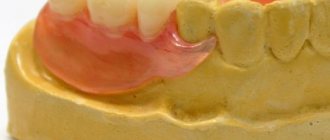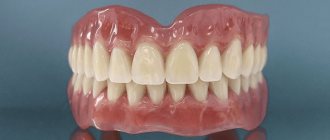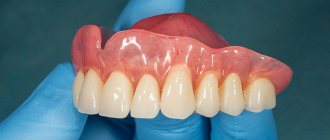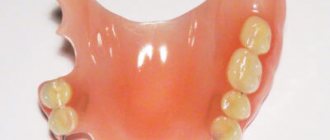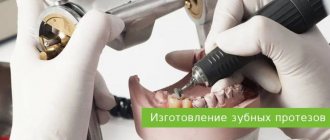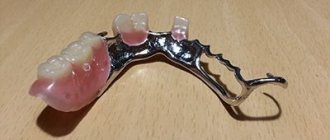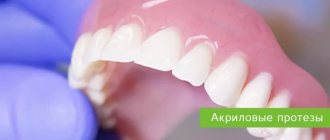- Indications
- Contraindications
- Advantages and disadvantages
- Kinds
- Clasp
- Made from nylon
- Lamellar
- Immediate dentures
- Manufacturing and installation
- Rehabilitation
- Care
- Prices
- Work examples
- Doctors
- Reviews
Despite the variety of implants, crowns and other methods of dental reconstruction, removable prosthetics does not lose demand, remaining an option for patients. Lightweight and strong structures compete with permanent dentures. This is a choice in cases where the patient cannot undergo implantation or have a fixed orthopedic system installed.
- When used:
missing from 1 tooth to completely edentulous - Type of anesthesia:
no need - Procedure time:
from 30 minutes (up to 4 visits) - Treatment period:
from 1.5 weeks to 3 weeks - Healing period:
from 3 weeks after the last removal - Age restrictions:
from 18 years old (in our clinic)
What dentures are best?
The type of system is selected individually. Taking into account the pros and cons of the designs, we draw the following conclusions:
- In case of partial loss of teeth and the presence of supporting teeth, clasp dentures will be an option. If there is an allergy to metals, choose QuattroTi dentures, acrylic, nylon models.
- If you have a toothless jaw, intolerance to acrylic and the impossibility of implantation, use plate Acry Free or nylon analogues.
Clasp dentures from 40,000 rub.
Nylon prostheses from 40,000 rub.
Lamellar dentures from 32,000 rub.
Butterfly prosthesis from 11,000 rub.
Quadrotti prosthesis from 64,500 rub.
Acri-Free prostheses from 47,000 rub.
Even with the same dental defects in two patients, prosthetics proceed differently. Only a doctor can tell which orthopedic product is the decision in this clinical situation, after examination and x-rays.
Removable dentures for complete absence of teeth
The sequence of actions is determined by the condition of the oral cavity, the number of lost teeth, the type of prosthetic system and the material of manufacture.
Basic stages of the process:
- diagnostics of the oral cavity with visual examination, x-rays, selection of materials and type of structure;
- preparing the site for the installation of a prosthesis (periodontal, orthodontic treatment, elimination of caries, depulpation of abutment teeth - if necessary);
- taking impressions to model a plaster jaw and develop an individual dental design;
- fitting of the finished prosthesis with its subsequent fitting (several visits to the dentist are allowed);
- final installation of the prosthesis and detailed consultation on its care.
On a note! To avoid unpleasant consequences of prosthetics (gum recession, irritation of mucous tissue, destruction of supporting crowns), you should visit the dentist every six months. This will help prevent the development of pathology in time and avoid drastic and expensive measures to eliminate it.
Advantages and disadvantages
Advantages
- Restoring the aesthetics and functioning of the dentition;
- used in complex clinical situations when reconstruction methods are impossible;
- selection of types of orthopedic products;
- installation without preliminary grinding of abutment teeth;
- variability of materials for manufacturing;
- without restrictions;
- speed of production and installation;
- repair of the orthopedic system in case of mechanical damage;
- ease of wearing and care;
- exceptional hygiene and safety;
- no age restrictions;
- use as a temporary prosthetic structure;
- service life (5-8 years);
- preservation of aesthetic indicators;
- price.
Flaws
- Restoration of chewing function is not complete;
- changes in diction, taste sensitivity during the period of adaptation;
- the likelihood of gum inflammation, irritation of the oral mucosa;
- uneven distribution of chewing loads;
- unable to stop or prevent jawbone atrophy;
- not all types of dentures and fixtures can be repaired;
- risk of damage to tooth enamel, development of cervical caries in the area where the attachments adhere to the supporting ones;
- relatively long period of adaptation;
- deformation and subsidence of the product (for metal-free structures);
- insufficient fastening on the lower jaw (applies to complete removable dentures).
Creation and installation of various prostheses: what are the stages and how long will it take?
Article navigation
- Stages of prosthetics
- - reorganization
- — photometry
- - casts
- - choice of prosthesis model
- — design and planning
- — creation of a prosthesis
- - first fitting
- — fixation of the structure
- - education
- How long does it take for production?
- Manufacturing time for fixed dentures
- Production time for removable devices
- Care
- QUESTIONS
Question for a specialist
Modern dental prosthetics are affordable and multivariate solutions for restoring the aesthetics of a smile and the function of chewing. In preparation for restoration, the patient goes through several preparatory stages, which include choosing a doctor and clinic, selecting a prosthetic technique and preliminary treatment - they can take from a couple of days to several months. Detailed materials about this can be found on our website. The creation and installation of structures also consist of various procedures. What stages are involved in direct dental prosthetics, and in what time frames the structures are made, we will describe in detail in this article.
Types of removable denture systems
Removable dentures – orthopedic products. They are removed and installed in the oral cavity independently. Dentures are made from biocompatible, elastic materials. Two kinds:
- Partial removable - installed if the patient is missing one or more in a row. These are plate, clasp, and immediate dentures. They are attached to supporting teeth or implants with fixing elements. Evenly distribute the load when chewing between the supports and gums.
- Full removable – in case of loss of teeth on one or both jaws. In such situations, it is impossible to secure the denture to a rigid support. Alternative fixation is used. The chewing load is placed on the gums.
Modern technologies provide strong fixation and precise fit to removable orthopedic systems. Patients note the ease of use and care.
Materials for the manufacture of removable dentures
The main requirements for the materials from which removable dentures are made are non-toxicity and the ability to look natural. A number of materials are used for these purposes, including:
- acrylic;
- plastic;
- zirconium;
- nylon;
- pressed ceramics;
- silicone;
- polyurethane;
- metal ceramics;
- clasp.
Based on what kind of material is used to create removable dentures, they receive certain properties. For example, the advantages of products made from metal ceramics and acrylic are strength and attractive appearance, while the advantage of products made from polyurethane and nylon is their flexibility. As for the shape and color of removable dentures, in all cases they are determined individually. Modern technologies provide the opportunity to create products with high aesthetic properties. Each of the listed materials has its own advantages and disadvantages. Therefore, when choosing, it is necessary to take into account the characteristics of each material and its suitability to your own needs. In solving this problem, recommendations from dentists can be of significant help.
Category Dentures Posted by admin
Clasp dentures
Clasp dentures are orthopedic structures made of artificial teeth on a base replicating natural gums, fixed on a durable metal arch (clasp). They correctly distribute the load when chewing without overloading the dental system. The condition for installing a clasp structure is a sufficient number of supports (teeth or implants) to which it is attached with hooks or clasps.
Removable dentures made of nylon
A base made of thin, elastic nylon on which artificial dental crowns are attached. Products are manufactured based on the clinical situation.
- The bioinert material does not contain metal impurities and does not cause allergies
, so the structures are not removed at night. - Since the color of the base is matched to the natural shade of the gums, the design is not noticeable and looks natural
.
Among the advantages are price, speed of adaptation, convenience. The only drawback of the design is that soft nylon sags and becomes deformed. But even so, the service life is 5-8 years
.
Plate dentures
A group of prosthetic systems for partial or complete restoration. The basis of the structures is a soft base that imitates part of the oral mucosa, with artificial tooth crowns attached to it. Representatives of this group of orthopedic products are structures made from acrylic-free plastic alloy “Acry Free” and the elastic QuattroTi prosthesis.
- Partially removable QuattroTi
is an orthopedic system manufactured using 3D modeling technology. The approach ensures the fit of the structure and comfort of wearing. Elastic hook retainers do not require grinding of the supporting teeth, are invisible, and harmless to tooth enamel. - Lightweight, flexible Acry Free
made from non-allergenic composites combine appearance and comfort with service life (5 years) and price. Used for partial or complete restoration. The advantage of an orthopedic system is the ability to repair if damaged.
Made from bioinert materials, the flexible, soft base is not paintable and does not change color during service. They have a number of disadvantages, like similar orthopedic products.
Removable dentures:
- Partial dentures are dentures that can be made when a patient is missing one tooth or a group of teeth. Even if the patient has only one tooth left in the jaw, this denture will still be partial
- Complete removable dentures are structures that are made in the absence of teeth.
- Clasp dentures or arched ones. (Bügel translated from German means arc). The arch connects the elements of the prosthesis to each other and is made of metal. Clasp dentures are smaller and, as a result, more comfortable than conventional removable dentures
Materials for the manufacture of removable dentures are acrylic plastic, nylon, acrylic-free plastic (acry free), metal + plastic (clasp dentures, removable dentures on attachments and on a beam).
Acrylic removable dentures.
Prostheses made from acrylic plastics are quite cheap, but have a number of serious disadvantages. For example, these may be allergic reactions to acrylic, unaesthetic appearance (due to the use of wire (metal) clasps that are visible on the teeth), supporting teeth must be covered with crowns since the clasps that secure the prosthesis lead to damage to the teeth. Also due to the fact that outdated manufacturing technology does not allow making an acrylic prosthesis accurately for its good fixation on the jaw. It is made to cover almost the entire palate. Which negatively affects the patient’s taste and temperature sensitivity; diction also suffers due to a completely closed palate. Acrylic dentures are the most difficult dentures for a patient to get used to. The service life of this prosthesis is up to 15 years if maintenance and relining (adding plastic) of the prosthetic bed are carried out periodically.
Nylon prostheses.
These are dentures that are much more comfortable than acrylic ones. They don't cover the entire sky. And as a result, the patient is more comfortable speaking and eating in them. They are more aesthetically pleasing than acrylic ones due to the use of nylon rather than metal clasps, which are fixed to the teeth and imitate gums. These clasps are also safe for the patient’s teeth and there is no need to cover the supporting teeth with crowns. The disadvantages of nylon prostheses include their fragility (maximum 5 years) and the impossibility of their repair. These prostheses are recommended to be used as temporary prosthetics before, during and after the installation of implants, before prosthetics with fixed structures.
Acry free.
Acrylic-free removable dentures are manufactured using the same technologies as nylon ones and have the same advantages. But they do not have the disadvantages of nylon prostheses. That is, they are aesthetic, functional, comfortable, durable and can be repaired. The only drawback of these prostheses is the cost, which is almost 2 times higher than the price of an acrylic prosthesis. Service life is up to 15 years, with regular maintenance and relocation.
Clasp dentures.
The frame of clasp dentures is made of metal and combines saddle-shaped overlays with artificial teeth and clasps or locks that are attached to the crowns of the patient’s teeth. The advantage of these prostheses is that they are very comfortable. They practically do not cover the sky (a thin strip of metal, an arc, runs across the sky). Very well fixed, strong and durable. The disadvantages of these dentures are that you need to take a large number of teeth under the supports and cover them with crowns, more frequent maintenance, the impossibility of repair if the metal frame is deformed or broken, and the price.
Removable dentures on implants.
These prostheses include attached prostheses and bar prostheses. Such dentures are used if a conventional removable denture, due to loss of jaw bone tissue, does not fit well and falls. Implants are used to improve fixation. Attachments or beams are screwed to them, and the mating parts of these attachments or beams are welded into the prostheses.
When making a prosthesis on attachments, it is necessary to install at least 4 implants. The outer part (attachment) is screwed onto these implants, which can be either spherical or cylindrical in shape, and a mating part is installed in the prosthesis, which is fixed to this attachment and the prosthesis fixed to these attachments turns out to be quite stable, well fixed, comfortable because With these prostheses, the part covering the palate can be significantly removed. For strength, a metal frame is welded into the prosthesis.
Removable denture on a beam.
Before making these prostheses, 4 implants must be installed. A titanium beam is made for these implants, which connects all 4 implants into a single block. And this ensures their ability to take on significant loads. Unlike prostheses with attachments, where the implants are disconnected and experience more uneven loads. The prosthesis has a mating part welded into plastic and a metal frame necessary for strength. This prosthesis is made with a completely open palate, located only on the alveolar ridge. And it is very convenient for patients. Thanks to powerful fixation and a small area of the closed gum.
Immediate dentures
Removable immediate dentures - to replace defects in the dentition during the production of a permanent orthopedic system. There are three types of such models - full, partial, butterfly.
They cope with the task, return partial work to a lost dental unit and hide a visual defect. The disadvantages include fragility, fragility, and long addiction.
Manufacturing and installation of a prosthesis
Includes stages:
- Preparatory and diagnostic – after hygienic cleaning, treatment, the patient undergoes a survey x-ray, CT scan of the jaw, which requires prosthetics.
- The dentist takes an impression and sends it to a dental laboratory.
- The production of an orthopedic system lasts on average 2 weeks. New technologies for taking impressions and 3D modeling make it possible to create anatomically verified structures that reproduce the chewing surface of each element down to the smallest detail.
- The doctor tries on the finished denture for the patient and corrects any discrepancies.
The final stage is fixation of the product in the oral cavity.
Indications and contraindications
Removable prosthetics are indicated if it is impossible to put a bridge in place of missing teeth. This happens with complete edentia, and with partial edentia - when the outer teeth or 4 or more adjacent teeth are missing. In addition, loose teeth are strengthened using removable dentures.
Installation of lower removable dentures is not carried out in case of diseases of the jaw bone tissue. In some cases, it is postponed until the causes are eliminated, which include:
- acute respiratory diseases or exacerbations of chronic ones;
- diseases of the oral cavity;
- pregnancy.
Manufacturing stages and installation
The production of a complete removable denture for the lower jaw goes through the following stages:
- Examination of the oral cavity, diagnosis, elimination of reasons that impede prosthetics.
- Taking an impression of the jaw and making a plaster model.
- Making a dental tray from a plaster impression.
- Fitting the spoon and obtaining a new impression - a functional one.
- Making a wax base with occlusal ridges.
- Using the resulting model, the doctor determines the patient’s central relationship between the lower and upper jaws. Anthropometric lines are drawn.
- Artificial teeth are placed.
- Checking the wax structure in the patient's mouth.
- The final stage: replacing wax with plastic, its polymerization, grinding and polishing.
After installation of the prosthesis, the patient receives recommendations on how to use the product. Manufacturing of the prosthesis takes 2 weeks. Getting used to it occurs within a month.
Care and service life
Removable dentures of the lower teeth require regular care and proper storage. Products cannot be kept in water or dry place. They are regularly washed under running water with a special product.
The service life depends on proper operation, design and material of manufacture.
Price
The price of removable dentures is dictated by the material of manufacture, design, and the number of artificial teeth. A simple covering prosthesis for the lower dentition can be obtained for 6-12 thousand rubles, Akri Free - from 30 thousand. Partially removable products are more expensive because they have imported fasteners and additional parts. The minimum cost of acrylic products with clasps is 15 thousand rubles, clasp structures – 20-25 thousand rubles, quadrotti – 40 thousand, “Sandwich” – from 49,000 rubles.
You can find out how much the structures will cost in your particular case after the initial examination, which is free in our clinic. Call the number and make an appointment!
Fixation of prostheses
Bugel, partial and full plate systems are attached to the mouth in different ways. Clasp ones are held in place with the help of clasps and attachments, partial plate ones - with soft fasteners, full plate ones - with a vacuum effect.
- Clasps
are metal hooks with which the prosthetic system clings to the base of the support units. - Attachments
are locks made of two components. One component is located on the prosthetic structure. The second is on the supporting tooth or implant. When putting on the orthopedic system, the clasp snaps tightly into place, holding the product in the mouth. - Vacuum effect
- flexible material fits closely to the gums and sticks to them. If necessary, increase the tightness of the seal, use “adhesive” pastes and gels.
Removable dentures are created using impressions from the patient. They are fixed in the mouth and do not fall out when chewing or playing sports.
Alekperov Roman Borisovich Dentist-orthopedist, doctor of the highest category
Is it necessary to remove a single tooth when performing removable dentures?
When talking about removable dental prosthetics of the lower jaw, they try to preserve their own teeth as much as possible. When replacing dentures in the upper jaw, single teeth must be removed. The decision is made by the doctor based on the clinical situation, after examination and diagnostic measures.
Alekperov Roman Borisovich Dentist-orthopedist, doctor of the highest category
There is only one tooth left on the upper jaw. Which denture should I choose so that the structure is held as tightly as possible and does not fall off?
If there is a single tooth in the upper jaw, only a partial, removable plate prosthetic system is likely to be manufactured. But such a design will not hold very firmly and in terms of reliability of fixation it is significantly inferior to prosthetics on implants. As an alternative, we recommend All-on-4, in which the denture is securely fixed to the jaw using only 4 titanium supports.
Alekperov Roman Borisovich Dentist-orthopedist, doctor of the highest category
On the left side of the upper jaw, 4 teeth in a row were lost. There are gold crowns on the lower jaw. Which removable denture is best placed on the upper jaw so that it does not conflict with the crowns?
In this case, it is possible to manufacture a partial removable lamellar denture based on acrylic or an Akri Free prosthesis. It is also possible to install the prosthesis on attachments or telescopic crowns. Since metal crowns are already present in the oral cavity, the best option would be Akri Free prosthetics.
YOUR QUESTIONS AND ANSWERS
QUESTION: Is it possible to make a new tooth if only one root remains from the old one? Or in such a situation, just remove the remains? Gera
ANSWER: If the root is preserved, then the tooth can be restored. There may be several options: use a pin or stump inlay for extension, followed by restoration of the supragingival part. The choice of method depends on the initial situation, so you can definitely say which one is suitable in your case after examining and taking a photo of the tooth.
QUESTION: After prosthetics for both jaws, I developed a problem in my upper jaw. I made a puller, the lower jaw fits well, but the upper jaw puts a lot of pressure on the attachment points. When I take off the prosthesis, the pain does not go away for another two days. I went to the doctor to have him loosen it, and now the prosthesis is falling off. Cornet
ANSWER: Dear Cornet, we are very sorry for your situation! First of all, it is important to understand that when installing removable structures, if you have not worn them before, there is an adaptation period. And in many cases it can be quite long and takes 2-3 months. During this time, you need to take out your removable denture only for cleaning after meals, but try to wear it the rest of the time so that the oral cavity adapts. In your situation, the compression of the gums at the attachment site could have been eased slightly, and over time the tissue would have gotten used to it. After the correction, the prosthesis began to fall out, perhaps due to the fact that the specialist was overzealous and removed a little more than necessary. Unfortunately, it is impossible to return the former boundaries of a removable denture - only to make a new one. Alternatively, you can try a special adhesive denture adhesive to improve bonding. It can be bought at a pharmacy.
1Belousov N.N. Time and sequence of stages of complex treatment of inflammatory periodontal diseases // Periodontology. – 2007. 2Razumnaya Z.V. Improving the technology of manufacturing dentures using CAD/CAM systems, 2012.
Author: Chorny S.V. (Thank you for your help in writing the article and the information provided)
How to quickly get used to a removable prosthetic system?
After installing a denture, it will take time to get used to it. To ensure that adaptation proceeds without problems, we recommend:
- Do not remove from mouth for long;
- suck on lollipops to suppress the feeling of nausea;
- read aloud to practice clear diction;
- For the first few days, follow a gentle diet.
Addiction lasts on average 2-4 weeks. If discomfort persists for more than a month, pain intensifies, gums become inflamed and bleed, you should consult a doctor.
Caring for dentures
They are not difficult to care for. All that is needed:
- Clean morning and evening with a soft brush and pastes that do not contain abrasives;
- rinse your mouth every time after eating;
- regularly treat with an antiseptic;
- give up sticky (chewing gum, toffee), excessively hard foods (nuts);
- Once every six months, take the denture to an orthopedist for cleaning and correction.
Compliance with these simple rules extends the service life and preserves the original appearance of dentures.
Article Expert
Alekperov Roman Borisovich Dentist-orthopedist, doctor of the highest category
Work experience: more than 32 years
Alternative Methods
Pterygoid implantation An innovative, low-traumatic method of restoring teeth with a lack of bone tissue in the upper jaw without sinus lifting and bone grafting
Zygomatic implantation A method of implanting the upper jaw, in which an elongated implant is fixed in the zygomatic bone in conditions of bone tissue atrophy
All-on-6 Fixed beam prosthesis on 6 implants without bone grafting
Article Expert
Pak Roman Vladimirovich Dentist-orthopedist, doctor of the highest category
Work experience: more than 30 years
Prices
Free online consultation with a dentist
| Service | Price |
| Removable and conditionally removable prosthetics | from 6,500 rub. |
| Installation of a temporary cosmetic plate (butterfly) | from 11,000 rub. |
| Installation of a complete or partially removable lamellar denture (acrylic, 1 jaw) | from 32,000 rub. |
| Installation of a clasp denture with clasps (1 jaw) | from 40,000 rub. |
| Installation of a partially removable nylon prosthesis (1 jaw) | from 40,000 rub. |
| Installation of a complete removable denture Akri Free (1 jaw) | from 47,000 rub. |
| Installation of a splinting clasp prosthesis (1 jaw) | from 55,000 rub. |
| Installation of a partially removable clasp prosthesis Quadrotti (1 jaw) | from 64,500 rub. |
| Installation of a locking clasp prosthesis (1 jaw) | from 70,000 rub. |
| Installation of a clasp denture on telescopic crowns (1 jaw) | from 75,000 rub. |
| Conditionally removable acrylic prosthesis on spherical attachments Rhein-83 for 1 jaw | from 121,000 rub. |
Consultation and diagnostics are free!
All prices Promotions
Patient reviews about removable dentures
Patient reviews of dentures, fully or partially removable, fixed, installed on implants, etc. depend on how well a particular method meets the person’s expectations and financial capabilities. The higher the cost of the design, the higher the expectations for their quality and wearing comfort, as a rule. However, in any case, restoration of the dentition and full chewing function evokes positive emotions, which means that the reviews are mostly good. True, for the sake of objectivity, it should be noted that the period of adaptation (especially with completely removable dentures) can leave a feeling of discomfort and foreignness of artificial teeth, which will soon pass. Reviews are also influenced by the level of professionalism of the orthopedic dentist and the accuracy of manufacturing.
Work examples
All works
Partial removable denture for chewing teeth
Restoration of both jaws with removable acrylic dentures
Conditionally removable prosthesis using a fastening system on Rhein-83 attachments
All works
Sign up for a consultation
three ROOTT specialists + diagnostics as a gift

